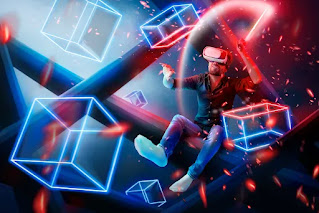Wear Those Shades.
Nonetheless, AR hasn't satisfied hopes. While a significant number of us have messed around like Pokemon Go! Furthermore, using canine channels via virtual entertainment locales like Instagram and Snapchat, we can't actually express that these things have genuinely affected our customary lives right now.
The shortfall of stuff to help AR is one of the most often referenced hindrances to its far and wide reception. What number of individuals do you have at least some idea who much of the time wears savvy glasses? Nonetheless, acknowledgment is expanding, and somewhere in the range of 2023 and 2027, the worldwide market for AR/VR brilliant glasses is supposed to develop by $7297.59M.
AR glasses are supposed to become famous in 2023, yet why? Kid Visser, an AR/VR master and tech writer, examines the new mechanical progressions that made the "amazing coincidence" for shrewd glasses in this video and talks about what lies next for AR.
Furthermore, it's inevitable before we witness an AR blast with up-and-coming businesses like the metaverse and 5G humming around. Where could it today, then, at that point, be? Where is it going, precisely?
The State of AR Right Now
Even though shrewd glasses with expanded reality capacities haven't totally assumed control more, a ton of utilizations for increasing the truth are currently being used.
Uses of today regularly take the state of Head-up Showcases (HUDs), which are straightforward presentations that current information without deterring the view, practically like a window with notes on it. Then again, actually, the notes are information that acclimates to the environmental elements being inspected.
HUDs were first made for use in quite a while. The Coordinated Visual Expansion Framework, a $22 billion program sent off by the American Armed Forces this year, will make blended reality fight goggles (IVAS). With the utilization of the new eyewear, troopers might convey continuously data like guides or adversary positions while they are participating in battle.
HUDs are currently used in different businesses, like business avionics and vehicles. As they can show significant data on a driver's windscreen, similar to headings, without requiring the driver to take their eyes off the street, HUDs are viewed as the subsequent stage in propelling driver experience, especially in vehicles. Automakers like Kia are as of now involving this sort of AR HUD in a few vehicles, including the Kia EV6, Kia Niro, and others.
Helped the Truth is an alternate form of AR that is being utilized in various fields. It is like Expanded Reality in that information is shown on a screen over the client's environmental elements, however, it is less vivid. One business, RealWear, makes head-mounted gadgets to help reality for cutting-edge laborers in enterprises like medical services, energy, fabricating, and auto.
As per Jon Arnold, VP of EMEA at RealWear, the essential use cases for XR (or expanded reality, which envelops both increased reality and helped reality) today are centered around business and security:
The motivation behind helped reality, as per him, is to keep up with the client's concentration and situational mindfulness in the actual climate while keeping an unmistakable view.
To help design from a distance, Arnold utilizes the case of RealWear head-mounted gadgets utilized in underway tasks. "These wearables permit a neighborhood designer to submit information to a far-off master continuously on the opposite side of the world while working in an extremely cruel and in some cases risky climate, for example, the downpour, high up, or adrift. The neighborhood designer can then safely execute the essential fixes continuously with the help of the distant master, who can now see the issue plainly through the eyes of the specialist. This is made sense of by Arnold.
What is ahead for augmented reality and smart glasses?
The potential for how these glasses will change our client experience — and lives — develops as computerized behemoths like Google, Macintosh, and Sorcery Jump inch nearer to delivering new sorts of shrewd glasses.
Take the metaverse as a representation. A completely vivid encounter is made conceivable by headsets like The Enchanted Jump 2, yet XR innovation isn't yet prepared for the metaverse (it's excessively expensive, excessively cumbersome, or simply not generally excellent). We discussed how The Enchanted Jump 2's broad and dimmable scope of view obscures the differentiation between expanded reality and augmented reality back in Spring. Clients will require shrewd glasses and goggles like these to ship them to the metaverse if they intend to invest any genuine energy there.
Be that as it may, innovation to the side, 5G seems, by all accounts, to be the principal part of AR's future turn of events.
One of the advances in the expanded reality area that has gotten the most consideration over the most recent four years is 5G, as most would consider to be normal to, in addition to other things, uncover the maximum capacity of AR, as per Arnold.
5G ought to give a new, far quicker network for AR to work on that is super low dormancy and high data transfer capacity. This is fundamental in empowering use cases like remote preparation and directed support and fixes, where a far-off repairman can leave remarks on harmed parts for on-location staff to peruse and afterward right fittingly.
In 2023, let's actually don smart glasses.
They will actually want to work all the more really and immediately with their global groups. What unequivocally does this resemble? Everybody partaking in a virtual gathering or show would have the option to get to similar material simultaneously and team up on continuous computerized content connection because of 5G-empowered AR.
Actually, it will be some time before this vision turns into a reality, as per Arnold, because 5G in the public organization today conveys no uplink transmission capacity gain. Be that as it may, he adds, the present 5G is still quite far from totally empowering AR and VR.
While we pause, we might hope to see really state-of-the-art savvy glasses applications arise, similar to the one the Japanese traditions office is taking on to battle sneaking. With these applications, the customs workforce can in a split second offer photos of merchandise with additional accomplished authorities somewhere else.
Arnold additionally prompts that we ought to start wearing shrewd glasses now as opposed to holding on until 5G is completely functional: "The main thing firms ought to accomplish a greater amount of in 2023 is dealing with individuals... to further develop reception of wearables today, and get individuals used to them."






_11zon.png)

No comments:
Post a Comment